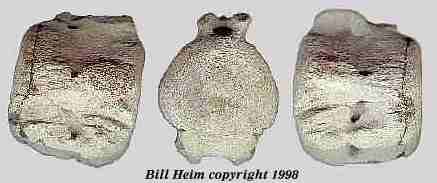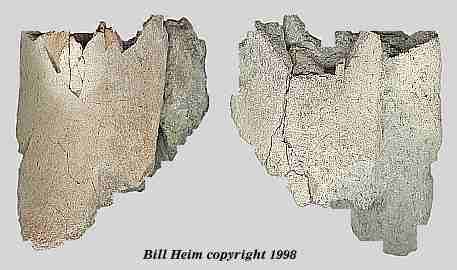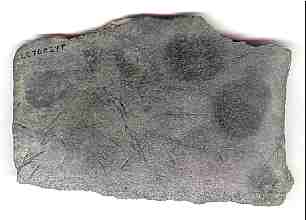|

Below are three views (right, left, and anterior) of a dolphin caudal vertebra from
the Yorktown formation which has been deeply bitten by a large shark. Notice that the deep
gashes shown in the left and right views were inflicted symmetrically by the upper and lower teeth as
evidenced in the anterior view. In addition to the large cut marks inflicted by a powerful bite,
smaller nicks and cuts were inflicted on the bone while it was being mouthed.
 |
| Fig. 1 - Dolphin caudal vertebra 53 mm long |
The below images are distal and proximal views of a portion of a large whale rib
from the Yorktown formation which had apparently been bitten clean through by a
large shark (probably Carcharocles due to the size of the teeth imprints). An
particularly impressive feat considering that the bone is 25mm (1 inch) thick.
The top of the distal image shows the impact of two of the wide upper teeth. The top
of the proximal image shows the impact of three of the narrower lower teeth. I have
observed similar damage to two other rib bones (including another one from Lee Creek).
Of particular interest is the spacing of the apparent bite marks which indicate that
the teeth of Carcharocles (if he was the culprit which appears likely to me)
are set closer together than those of Carcharodon, thus the jaw and
overall size may be somewhat smaller than estimates based on scaled up
Carcharodon jaws.
The bone shows possible evidence of partial digestion. The
bone may have been swallowed, partially digested and then
later regurgitated (a common occurance with sharks).
 |
| Fig. 2 - Whale rib fragment 80mm x 65mm x 25mm. |
The next image depicts a dolphin rib from the Yorktown which has been chewed on by sharks
and probably partially digested. In addition to marks which appear to be single cuts, there
are parallel serration marks, indicating a genus such as Carcharocles, Carcharodon,
or Galeocerdo.
 |
| Fig. 3 - Dolphin rib fragment 103 mm. |
This turtle plastron (lower shell) from probably either the Chowan River or James City formation
shows evidence of shark feeding. It is covered with numerous scratches and cuts (some of which
barely show up in the image). Modern turtles are often fed upon by tiger sharks (Galeocerdo
cuvier), white sharks (Carcharodon carcharias) and bull sharks (Carcharhinus
leucas) among others. All three of the above species are found in Lee Creek deposits.
 |
| Fig. 4 - Turtle plastron 115 mm. |
|